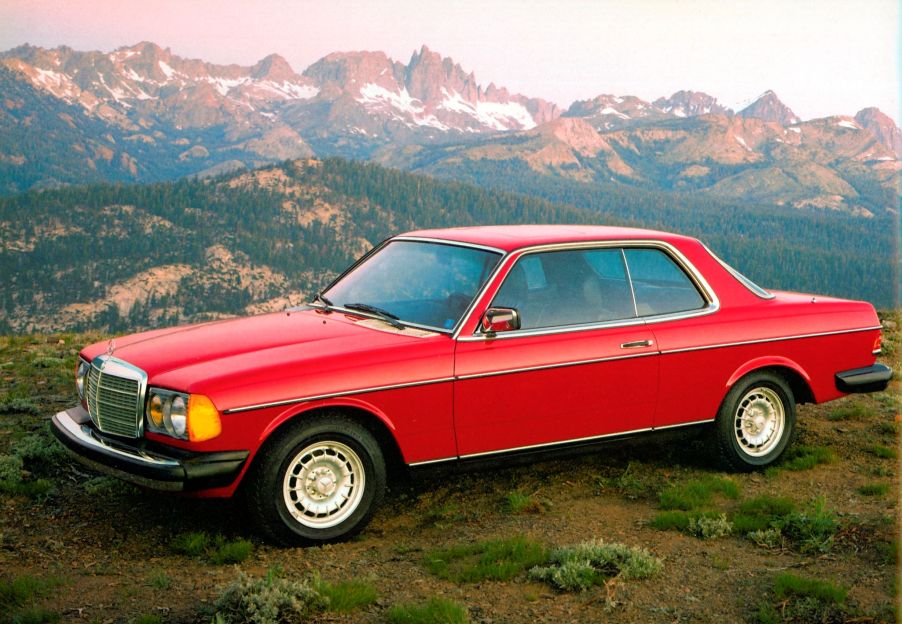
A Diesel W123 Mercedes Is a Slow but Unkillable Classic Tank
It’s hard to deny classic luxury cars’ appeal, but it’s equally difficult to dismiss reliability and running cost fears. However, some vintage luxury vehicles can last a lifetime with proper care. And there’s one kind of classic that’s internationally known for its sheer stalwart service, if not its performance. There are undoubtedly faster classic cars, but few can outlast the diesel W123 Mercedes.
It’s beautifully simple, but a non-turbocharged diesel W123 Mercedes is painfully slow

| 1976-1985 W123 Mercedes Diesel | |
| Models | 240D 300D/300CD/300TD (1976-1980) 300D/300CD/300TD Turbodiesel (1981-1985) |
| Engine | 240D: 2.4-liter ‘OM616’ four-cylinder 300D/300CD/300TD: 3.0-liter ‘OM617’ five-cylinder 300D/300CD/300TD Turbodiesel: 3.0-liter ‘OM617’ turbodiesel five-cylinder |
| Horsepower | 240D: 62 hp (1976-1980), 67 hp (1981-1985) 300D/300CD/300TD: 77 hp 300D/300CD/300TD Turbodiesel: 125 hp |
| Torque | 240D: 97 lb-ft 300D/300CD/300TD: 115 lb-ft 300D/300CD/300TD Turbodiesel: 181 lb-ft |
| Transmission | Four-speed manual Three- (1976-1980) and four-speed (1981-1985) automatic |
| 0-60 mph time | 240D: 22 seconds (Hagerty) 300D: 21 seconds (MotorTrend) 300D Turbodiesel: 14 seconds (MotorTrend) |
Mercedes and diesel engines go back a long way. The German automaker was the first to offer a diesel engine in a production vehicle back in 1935, MotorTrend explains. At one point, 79% of all new Mercedes-Benz cars sold had diesel engines. And the W123 Mercedes 300D sedan (and the 300CD coupe and 300TD wagon) was the first production car with a turbodiesel engine.
It desperately needed that turbodiesel, too. Although the W123 Mercedes was never a sports sedan like the 190E, it was slow even by late-1970s standards. But then, speed wasn’t on Mercedes’ mind when it designed the W123, the precursor to today’s E-Class. And while the diesel W123s aren’t fast, they’re durable even by modern diesel standards.
A W123 Mercedes 300D or 240D isn’t fast, but it’s durable enough to survive “until the heat death of the universe,” MotorTrend says
For one, like all diesel engines, the OM616 and OM617 in the W123 Mercedes rely on compression ignition. So, they have no spark plugs, just glow plugs to warm the block on cold mornings. However, unlike some modern diesel vehicles, the W123 doesn’t need two batteries. That’s because, rather than using electricity—or, as the 600 Grosser did, hydraulics—to run different components, the W123 uses mechanical vacuum-driven parts. The door locks, windows, even the oil-pressure gauge are all mechanical. Fewer electronics mean you don’t need more batteries.
Also, while modern diesel fuel is cleaner than you might think, a W123 Mercedes 240D or 300D doesn’t have to run on it. Because it has a mechanical fuel pump, you can easily adapt it to run on biofuel or used vegetable oil. And plenty owners have, Hagerty notes.

But it’s not just the diesel powertrain that’s stout on the W123 Mercedes: the entire car is. German taxicab drivers them through hundreds of thousands of miles of commuter hell and they just kept truckin’. A gasoline-powered 280E won the 30,000-mile London- Sydney Marathon Rally in 1977, with three more W123s finishing in the top ten. And even 40-plus years later, these cars are still robust enough for daily use. Little wonder that potential buyers were reportedly trying to bribe Mercedes workers for earlier spots on the W123 waiting list.
Also, for a late-1970s/early-1980s car, a diesel W123 Mercedes is rather advanced. It has safety crumple zones, a collapsible steering column, four-wheel discs with optional ABS, and by 1982, airbags. And with double-wishbone suspension, it provides “absolute comfort on the bumpiest roads,” Hagerty says.
Keep up with maintenance and you’ll have a tough affordable classic luxury car
It’s worth remembering that durability and reliability aren’t necessarily synonyms. A diesel W123 Mercedes still has maintenance needs, and being a classic car, its service intervals are shorter.
And while it doesn’t have many electrical components, its vacuum-based systems can fail as its various gaskets and hoses degrade. Also, rust is still an issue, even with the later, better-protected models. The diesel motors also benefit from regular fuel filter changes and system clean-outs, aka ‘purges.’ Plus, the mechanical gauges can break or wear out, as can the TD’s self-leveling rear suspension, Hemmings notes.
However, while replacement parts are going up in price, Mercedes made literally millions of W123s. So, finding parts isn’t exactly difficult. And although they’re not as cheap as they once were, diesel W123s are still affordable. A good-to-excellent condition 240D, for example, typically costs $10K-$20K, Hagerty says. And a W123 Mercedes 300D in the same condition usually tops out at $24,000. Even a pristine one typically costs about $36,000.
A diesel W123 Mercedes is definitely the tortoise of the classic luxury car world. But then, who beat the hare in that story?
Follow more updates from MotorBiscuit on our Facebook page.


